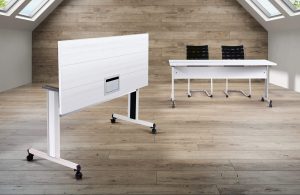Meetings. We love them in the business world.
Meetings upon meetings to discuss the next meeting. Hours spent chatting and developing ideas, only to walk away not entirely knowing what you met for and what to do now. Sound familiar?
In a world where time is money, efficient meetings are key. Not only to success but for the benefit of your staff According to research on the subject, 47% of people surveyed cited “too many meetings” as the main time-waster in their roles, whereas 39% of people admitted to actually dozing off mid-meeting. Hardly the most productive way to spend your time in the office.

So how do you avoid your staff members feeling like they’re wasting their time? Here are eight ways to keep your meetings efficient, effective and productive:
1. Do you really need a meeting?
The first question to ask is whether you need a meeting at all. Can it instead be resolved via an email? Or do your colleagues need to step away from their desks to discuss something that could be sorted over the phone in a 10-minute conference call?
2. Choose the right time.

If you really do need a meeting, then schedule an appropriate time of day. Don’t choose a slot that’s too early, leaving colleagues little time to prepare after their first day’s coffee. And don’t schedule right before or after lunch either. Before, and you’ll risk losing people’s attention as their mind wanders to a rumbling stomach. After, and you’ll get the post-lunch slump. Concentration levels will not be as high as people are naturally more tired immediately after eating.
Lastly, avoid the end of the working day, too, when people are getting ready to clock off and get out of the office. Meetings will be rushed and concentration levels even lower.
The best times are between 9am and 11am, and 2pm and 4pm, Tuesday through to Thursday. No Friday afternoon meetings, please.
3. Have a clear agenda.
Have a clear agenda and stick to it, so that you and everyone attending knows exactly what will be covered and when. This should stop conversation going off on an unproductive tangent, but if you see this happening, bring the focus back to the agenda and get back on track. Bonus points for sending the agenda out to all attendees before the meeting. Don’t forget the all-important AOB at the end, giving people a chance to add anything else.
4. Only include the necessary people.
Speaking of attendees, invite only those who are essential to the meeting. Do you really need four people from one team? Think carefully. If it won’t add anything productive to that person’s day, or bring any business advantage, don’t include them.
5. Make sure your space has suitable furniture.

Chances are your meeting will be held in an office-type environment, so you’ll need furniture that works for you. Do you need sockets? Cable tidies? Modesty panels? Tables like Burgess’ Configure-8 Flip Top are perfect for these situations as they include all of these things. If your meeting will take place in more of a ‘pop-up’ space, then Meet-U® with its bridge tops, allow for quick assembly in multiple shapes, minimal tables legs and seamless design. Not in charge of the furniture? Get those with the decision to click here.
6. Keep people comfortable.
Whilst we’re talking about furniture, ergonomics is essential. You don’t want attendees to be fidgeting around on uncomfortable seats, which means they’re not focussing on the task at hand. Let alone, be suffering from poor posture. Choose seating with foam padded cushions, like Vario-Allday™, complete with lumbar support, or Forum with its flexible, breathable mesh back and added armrests. Why not view our full meeting range?
7. Take notes, or follow up.

This is essential if you want to get things done. Either invite someone solely to take notes, or write up a detailed follow-up with actionable points for all in attendance. You’ll want to make sure everyone walks away knowing exactly what they need to do next.
8. Keep track of time.
If you set up a meeting to last no more than half an hour, stick to it. The chances are your attendees have plenty of other work to be doing or other meetings to go to, so don’t allow meetings to overrun. Start on time, and end on time. Worried you won’t get it all done? Either schedule a slightly longer meeting or focus on point 3. For extra help, why not try Nicole Steinbok’s 22-minute meeting strategy?
To see our full range of meeting furniture, visit our website or contact us directly for a showroom tour, brochure or more information.
